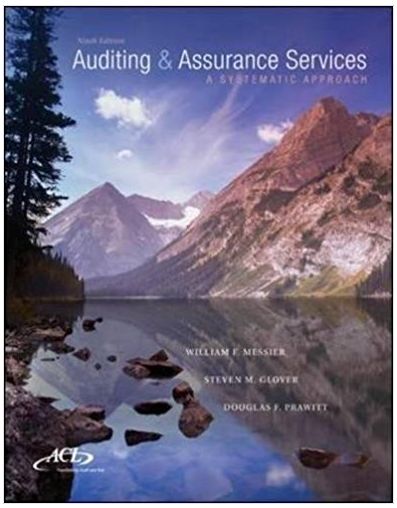1. For the control activities to be effective, employees maintaining the accounts receivable subsidiary ledger should not...
Question:
a. Employee overtime wages.
b. Credit granted to customers.
c. Write- offs of customer accounts.
d. Cash disbursements.
2. Which of the following controls is most likely to help ensure that all credit revenue transactions of an entity are recorded?
a. The billing department supervisor sends a copy of each approved sales order to the credit department for comparison to the customer€™s authorized credit limit and current account balance.
b. The accounting department supervisor independently reconciles the accounts receivable subsidiary ledger to the accounts receivable control account each month.
c. The accounting department supervisor controls the mailing of monthly statements to customers and investigates any differences reported by customers.
d. The billing department supervisor matches pre-numbered shipping documents with entries in the sales journal.
3. Which of the following internal controls would be most likely to deter the lapping of collections from customers?
a. Independent internal verification of dates of entry in the cash receipts journal with dates of daily cash summaries.
b. Authorization of write- offs of uncollectible accounts by a supervisor independent of the credit approval function.
c. Segregation of duties between receiving cash and posting the accounts receivable ledger.
d. Supervisory comparison of the daily cash summary with the sum of the cash receipts journal entries.
4. Smith Corporation has numerous customers. A customer file is maintained and includes a customer record with a name, an address, a credit limit, and an account balance. The auditor wishes to test this file to determine whether credit limits are being exceeded. The best procedure for the auditor to follow would be to
a. Develop test data that would cause some account balances to exceed the credit limit and determine if the system properly detects such situations.
b. Develop a program to compare credit limits with account balances and print out the details of any account with a balance exceeding its credit limit.
c. Request a printout of all account balances so that they can be manually checked against the credit limits.
d. Request a printout of a sample of account balances so that they can be individually checked against the respective credit limits.
5. Cash receipts from sales on account have been misappropriated. Which of the following acts would conceal this defalcation and be least likely to be detected by an auditor?
a. Understating the sales journal.
b. Overstating the accounts receivable control account.
c. Overstating the accounts receivable subsidiary ledger.
d. Understating the cash receipts journal.
6. If accounts receivable turnover (credit sales/ receivables) was 7.1 times in 2013 compared to only 5.6 times in 2014, it is possible that there were
a. Unrecorded credit sales in 2014.
b. Unrecorded cash receipts in 2013.
c. More thorough credit investigations made by the company late in 2013.
d. Fictitious sales in 2014.
7. If the number of days€™ sales in accounts receivable (365 days/ receivables turnover) decreases significantly, which of the following assertions for accounts receivable most likely is violated?
a. Existence or occurrence.
b. Completeness.
c. Rights and obligations.
d. Classification.
8. Which of the following is most likely to be detected by an auditor€™s review of an entity€™s sales cutoff?
a. Unrecorded sales for the year.
b. Lapping of year- end accounts receivable.
c. Excessive sales discounts.
d. Unauthorized goods returned for credit.
9. Negative confirmation of accounts receivable is less effective than positive confirmation of accounts receivable because
a. A majority of recipients usually lack the willingness to respond objectively.
b. Some recipients may report incorrect balances that require extensive follow- up.
c. The auditor cannot infer that all non-respondents have verified their account information.
d. Negative confirmations do not produce evidence that is statistically quantifable.
10. The negative request form of accounts receivable confirmation is useful particularly when
.png)
11 An auditor should perform alternative procedures to substantiate the existence of accounts receivable when
a. No reply to a positive confirmation request is received.
b. No reply to a negative confirmation request is received.
c. The collectability of the receivables is in doubt.
d. Pledging of the receivables is probable.
12. In evaluating the adequacy of the allowance for doubtful accounts, an auditor most likely reviews the entity€™s aging of receivables to support management€™s financial statement assertion of
a. Existence.
b. Valuation and allocation.
c. Completeness.
d. Rights andobligations.
Accounts receivables are debts owed to your company, usually from sales on credit. Accounts receivable is business asset, the sum of the money owed to you by customers who haven’t paid.The standard procedure in business-to-business sales is that... Corporation
A Corporation is a legal form of business that is separate from its owner. In other words, a corporation is a business or organization formed by a group of people, and its right and liabilities separate from those of the individuals involved. It may...
Fantastic news! We've Found the answer you've been seeking!
Step by Step Answer:
Related Book For 

Auditing and Assurance Services A Systematic Approach
ISBN: 978-1259162343
9th edition
Authors: William Messier, Steven Glover, Douglas Prawitt
Question Posted:





